check engine SKODA YETI 2010 1.G / 5L User Guide
[x] Cancel search | Manufacturer: SKODA, Model Year: 2010, Model line: YETI, Model: SKODA YETI 2010 1.G / 5LPages: 271, PDF Size: 14.71 MB
Page 37 of 271
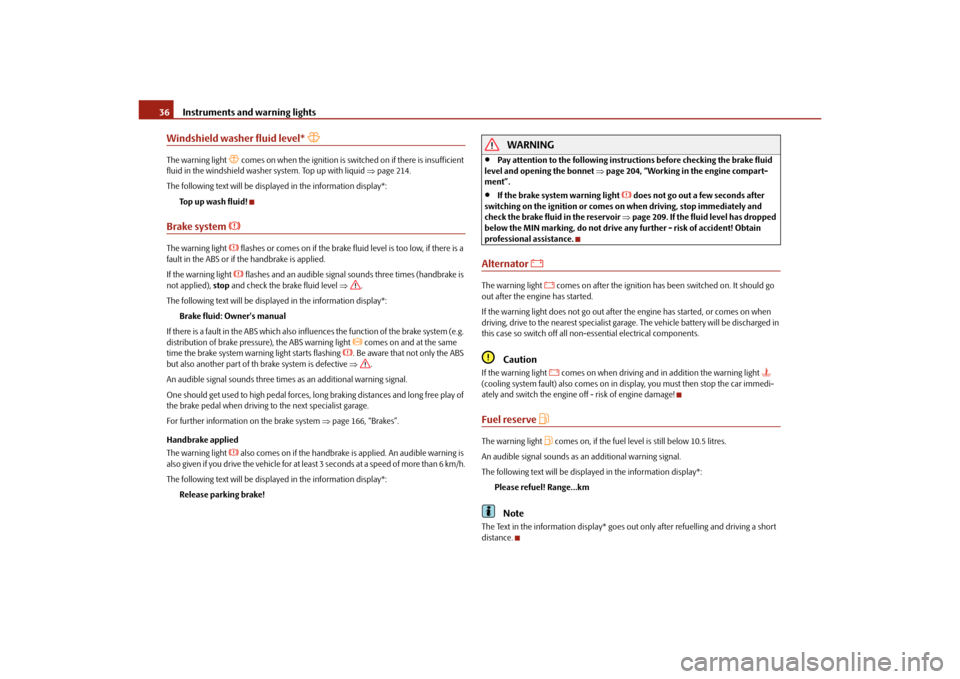
Instruments and warning lights
36
Windshield washer fluid level*
The warning light
comes on when the ignition is switched on if there is insufficient
fluid in the windshield washer system. Top up with liquid page 214.
The following text will be displayed in the information display*: Top up wash fluid!
Brake system
The warning light
flashes or comes on if the brake fluid level is too low, if there is a
fault in the ABS or if the handbrake is applied.
If the warning light flashes and an audible signal sounds three times (handbrake is
not applied), stop and check the brake fluid level .
The following text will be displayed in the information display*: Brake fluid: Owner's manual
If there is a fault in the ABS which also influences the function of the brake system (e.g.
distribution of brake pressure), the ABS warning light
comes on and at the same
time the brake system warning light starts flashing
. Be aware that not only the ABS
but also another part of th brake system is defective .
An audible signal sounds three times as an additional warning signal.
One should get used to high pedal forces, lo ng braking distances and long free play of
the brake pedal when driving to the next specialist garage.
For further information on the brake system page 166, “Brakes”.
Handbrake applied
The warning light
also comes on if the handbrake is applied. An audible warning is
also given if you drive the vehicle for at least 3 seconds at a speed of more than 6 km/h.
The following text will be displayed in the information display*:
Release parking brake!
WARNING
Pay attention to the following instruct ions before checking the brake fluid
level and opening the bonnet page 204, “Working in the engine compart-
ment”.
If the brake system warning light
does not go out a few seconds after
switching on the ignition or comes on when driving, stop immediately and
check the brake fluid in the reservoir page 209. If the fluid level has dropped
below the MIN marking, do not drive any further - risk of accident! Obtain
professional assistance.
Alternator
The warning light
comes on after the ignition has been switched on. It should go
out after the engine has started.
If the warning light does not go out after the engine has started, or comes on when
driving, drive to the nearest specialist garage. The vehicle battery will be discharged in
this case so switch off all non-essential electrical components.
Caution
If the warning light
comes on when driving and in addition the warning light
(cooling system fault) also comes on in display, you must then stop the car immedi-
ately and switch the engine off - risk of engine damage!
Fuel reserve
The warning light
comes on, if the fuel level is still below 10.5 litres.
An audible signal sounds as an additional warning signal.
The following text will be displayed in the information display*: Please refuel! Range...km
Note
The Text in the information display* goes ou t only after refuelling and driving a short
distance.
s2ug.6.book Page 36 Friday, April 9, 2010 2:24 PM
Page 97 of 271
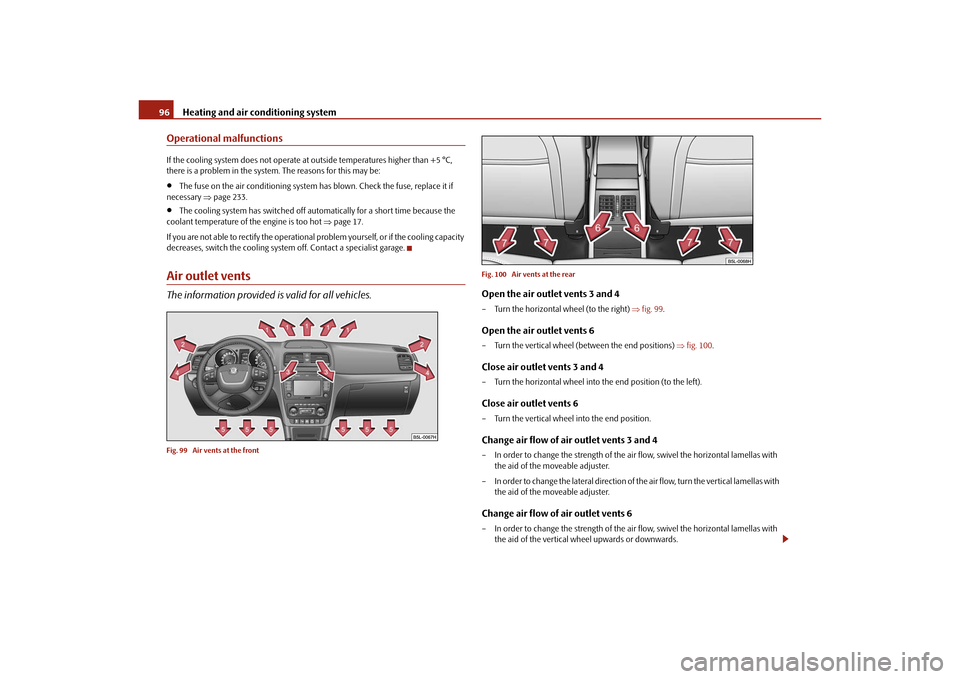
Heating and air conditioning system
96
Operational malfunctionsIf the cooling system does not operate at outside temperatures higher than +5 °C,
there is a problem in the system. The reasons for this may be:
The fuse on the air conditioning system has blown. Check the fuse, replace it if
necessary page 233.
The cooling system has switched off automatically for a short time because the
coolant temperature of the engine is too hot page 17.
If you are not able to rectify the operational problem yourself, or if the cooling capacity
decreases, switch the cooling system off. Contact a specialist garage.
Air outlet ventsThe information provided is valid for all vehicles.Fig. 99 Air vents at the front Fig. 100 Air vents at the rear
Open the air outlet vents 3 and 4– Turn the horizontal wheel (to the right)
fig. 99 .Open the air outlet vents 6– Turn the vertical wheel (between the end positions) fig. 100 .Close air outlet vents 3 and 4– Turn the horizontal wheel into the end position (to the left).Close air outlet vents 6– Turn the vertical wheel into the end position.Change air flow of air outlet vents 3 and 4– In order to change the strength of the air flow, swivel the horizontal lamellas with
the aid of the moveable adjuster.
– In order to change the lateral direction of the air flow, turn the vertical lamellas with the aid of the moveable adjuster.Change air flow of air outlet vents 6– In order to change the strength of the air flow, swivel the horizontal lamellas with
the aid of the vertical wheel upwards or downwards.
s2ug.6.book Page 96 Friday, April 9, 2010 2:24 PM
Page 109 of 271

Starting-off and Driving
108
Starting-off and DrivingSetting steering wheel positionFig. 105 Adjustable steering wheel: Lever next to the steering column / safe distance to the
steering wheelYou can set the height and the forward/back position of the steering wheel to the
desired position.
– Adjust the driver seat page 12.
– Pull the lever below the steering wheel down fig. 105 - left .
– Set the steering wheel to the desired position (concerning height and forward/back position).
– Push the lever upwards as far as the stop.
WARNING
You must not adjust the steering wheel when the vehicle is moving!
The driver must maintain a distance of at least 25 cm to the steering wheel
fig. 105 . Not maintaining this minimum dist ance will mean that the airbag
system will not be able to properly protect you - hazard!
For safety reasons the lever must always be firmly pushed up to avoid the
steering wheel altering its po sition unintentionally when driving - risk of acci-
dent!
If you adjust the steering wheel furthe r towards the head, you will reduce
the protection offered by the driver airbag in the event of an accident. Check
that the steering wheel is aligned to the chest.
When driving, hold the steering wheel with both hands firmly on the outer
edge in the 9 o'clock and 3 o'clock position. Never hold the steering wheel
firmly in the 12 o'clock position or in another way (e.g. in the middle of the
steering wheel or at the inne r steering wheel edge). In such cases, injuries to the
arms, the hands and the head can occur when the driver airbag is deployed.
Ignition lockPetrol engines
- ignition switched off, engine off, the steering can be locked.
- ignition switched on
- start engine
Diesel engines - interruption of fuel supply, ignition swit ched off, engine off, the steering can be
locked.
- heating glow plugs on, ignition switched on
WARNING (continued)
Fig. 106 Ignition lock positions
A1A2A3A1A2
s2ug.6.book Page 108 Friday, April 9, 2010 2:24 PM
Page 111 of 271
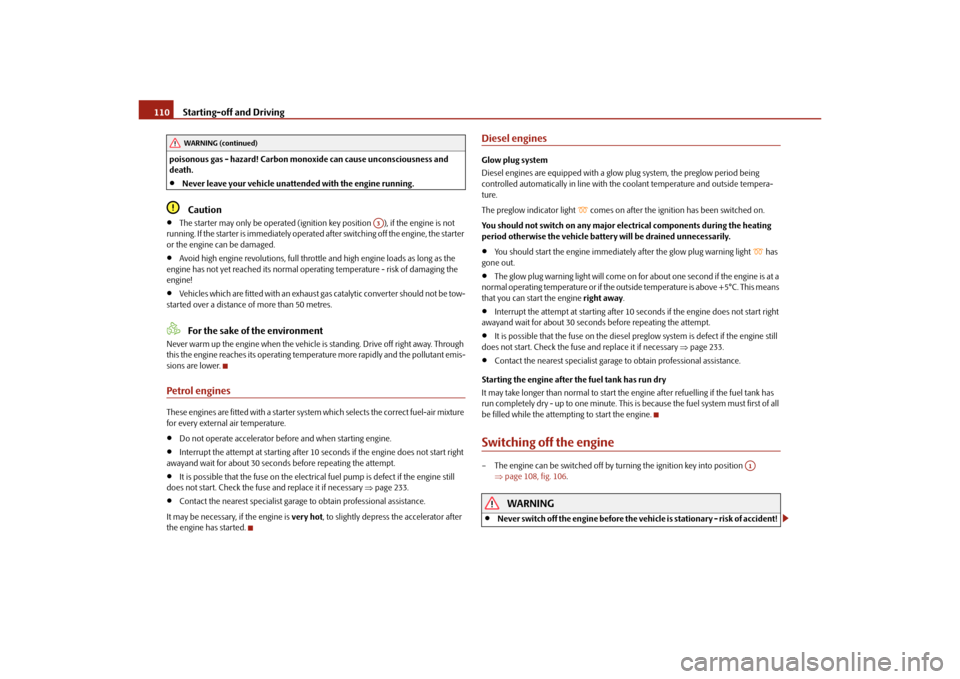
Starting-off and Driving
110
poisonous gas - hazard! Carbon monoxide can cause unconsciousness and
death.
Never leave your vehicle unattended with the engine running.Caution
The starter may only be operated (ignitio n key position ), if the engine is not
running. If the starter is immediately operated after switching off the engine, the starter
or the engine can be damaged.
Avoid high engine revolutions, full throttle and high engine loads as long as the
engine has not yet reached its normal oper ating temperature - risk of damaging the
engine!
Vehicles which are fitted with an exhaust gas catalytic converter should not be tow-
started over a distance of more than 50 metres.For the sake of the environment
Never warm up the engine when the vehicle is standing. Drive off right away. Through
this the engine reaches its operating temperature more rapidly and the pollutant emis-
sions are lower.Petrol enginesThese engines are fitted with a starter system which selects the correct fuel-air mixture
for every external air temperature.
Do not operate accelerator before and when starting engine.
Interrupt the attempt at starting after 10 seconds if the engine does not start right
awayand wait for about 30 seconds before repeating the attempt.
It is possible that the fuse on the electric al fuel pump is defect if the engine still
does not start. Check the fuse and replace it if necessary page 233.
Contact the nearest specialist garage to obtain professional assistance.
It may be necessary, if the engine is very hot, to slightly depress the accelerator after
the engine has started.
Diesel enginesGlow plug system
Diesel engines are equipped with a glow plug system, the preglow period being
controlled automatically in line with the coolant temperature and outside tempera-
ture.
The preglow indicator light
comes on after the ignition has been switched on.
You should not switch on any major electrical components during the heating
period otherwise the vehicle battery will be drained unnecessarily.
You should start the engine immediately after the glow plug warning light
has
gone out.
The glow plug warning light will come on for about one second if the engine is at a
normal operating temperature or if the outside temperature is above +5°C. This means
that you can start the engine right away.
Interrupt the attempt at starting after 10 seconds if th e engine does not start right
awayand wait for about 30 seconds before repeating the attempt.
It is possible that the fuse on the diesel preglow system is defect if the engine still
does not start. Check the fuse and replace it if necessary page 233.
Contact the nearest specialist garage to obtain professional assistance.
Starting the engine after the fuel tank has run dry
It may take longer than normal to start the engine after refuelling if the fuel tank has
run completely dry - up to one minute. This is because the fuel system must first of all
be filled while the attempting to start the engine.
Switching off the engine– The engine can be switched off by tu rning the ignition key into position
page 108, fig. 106.
WARNING
Never switch off the engine before the vehicle is stationary - risk of accident!
WARNING (continued)
A3
A1
s2ug.6.book Page 110 Friday, April 9, 2010 2:24 PM
Page 177 of 271
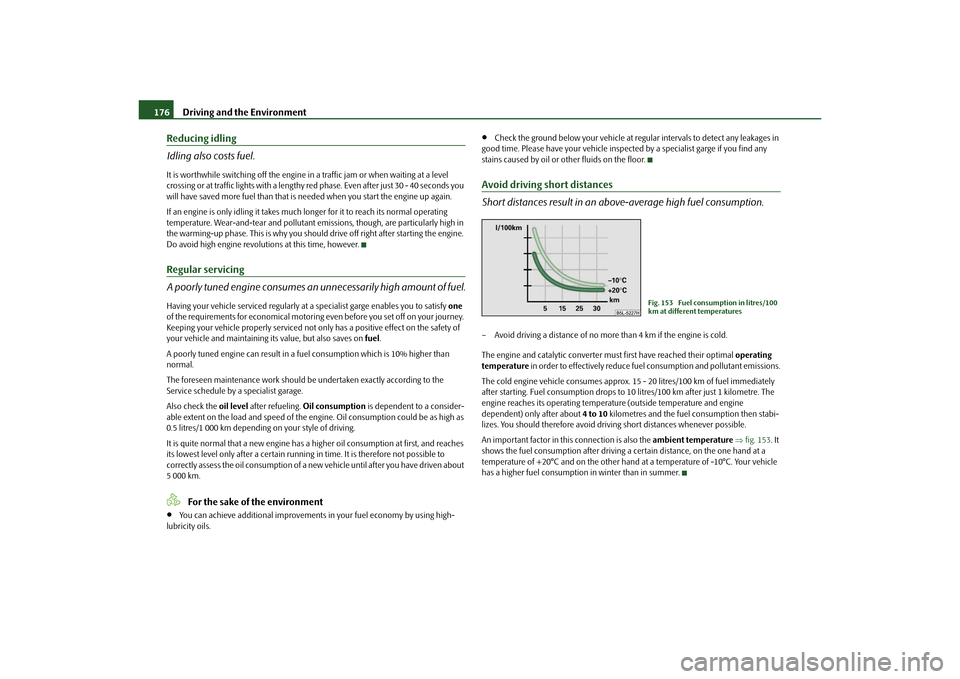
Driving and the Environment
176
Reducing idling
Idling also costs fuel.It is worthwhile switching off the engine in a traffic jam or when waiting at a level
crossing or at traffic lights with a lengthy red phase. Even after just 30 - 40 seconds you
will have saved more fuel th an that is needed when you start the engine up again.
If an engine is only idling it takes much longer for it to reach its normal operating
temperature. Wear-and-tear and pollutant emis sions, though, are particularly high in
the warming-up phase. This is why you should drive off right after starting the engine.
Do avoid high engine revolu tions at this time, however.Regular servicing
A poorly tuned engine consumes an unnecessarily high amount of fuel.Having your vehicle serviced regularly at a specialist garge enables you to satisfy one
of the requirements for economical motoring even before you set off on your journey.
Keeping your vehicle properly serviced not on ly has a positive effect on the safety of
your vehicle and maintaining its value, but also saves on fuel.
A poorly tuned engine can result in a fu el consumption which is 10% higher than
normal.
The foreseen maintenance work should be undertaken exactly according to the
Service schedule by a specialist garage.
Also check the oil level after refueling. Oil consumption is dependent to a consider-
able extent on the load and speed of the en gine. Oil consumption could be as high as
0.5 litres/1 000 km depending on your style of driving.
It is quite normal that a new engine has a higher oil consumption at first, and reaches
its lowest level only after a certain running in time. It is therefore not possible to
correctly assess the oil consumption of a new vehicle until after you have driven about
5 000 km.
For the sake of the environment
You can achieve additional improvements in your fuel economy by using high-
lubricity oils.
Check the ground below your vehicle at regular intervals to detect any leakages in
good time. Please have your vehicle inspec ted by a specialist garge if you find any
stains caused by oil or other fluids on the floor.
Avoid driving short distances
Short distances result in an above-average high fuel consumption.– Avoid driving a distance of no more than 4 km if the engine is cold.
The engine and catalytic converter mu st first have reached their optimal operating
temperature in order to effectively reduce fuel consumption and pollutant emissions.
The cold engine vehicle cons umes approx. 15 - 20 litres/100 km of fuel immediately
after starting. Fuel co nsumption drops to 10 litres/100 km after just 1 kilometre. The
engine reaches its operating temperat ure (outside temperature and engine
dependent) only after about 4 to 10 kilometres and the fuel consumption then stabi-
lizes. You should therefore avoid driving short distances whenever possible.
An important factor in this connection is also the ambient temperature fig. 153 . It
shows the fuel consumption af ter driving a certain distance, on the one hand at a
temperature of +20°C and on the other hand at a temperature of -10°C. Your vehicle
has a higher fuel consumptio n in winter than in summer.
Fig. 153 Fuel consumption in litres/100
km at different temperatures
s2ug.6.book Page 176 Friday, April 9, 2010 2:24 PM
Page 178 of 271
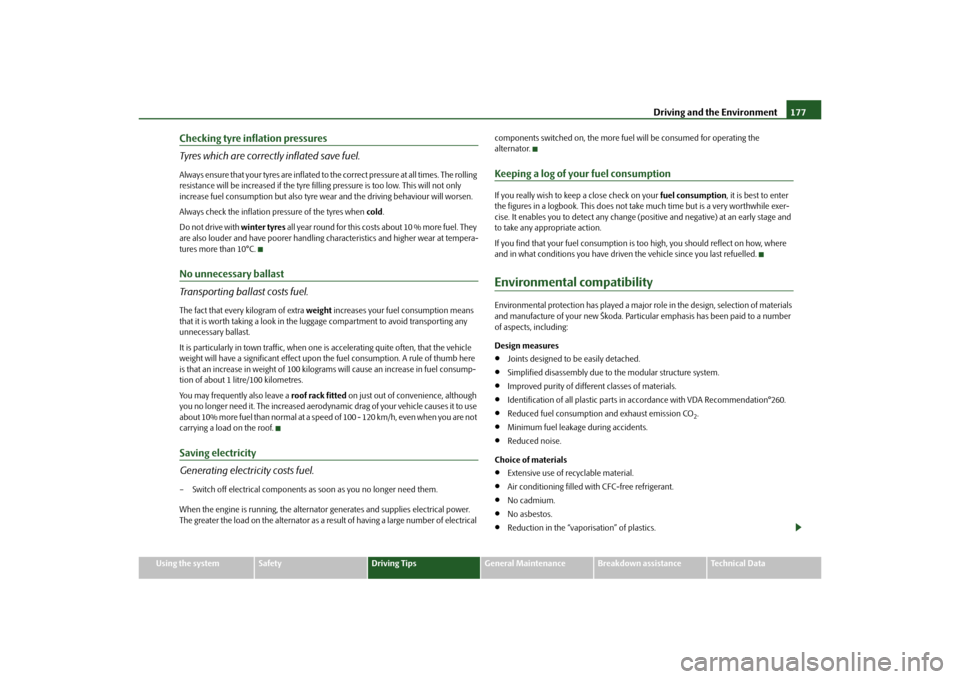
Driving and the Environment177
Using the system
Safety
Driving Tips
General Maintenance
Breakdown assistance
Technical Data
Checking tyre inflation pressures
Tyres which are correctly inflated save fuel.Always ensure that your tyres are inflated to the correct pressure at all times. The rolling
resistance will be increased if the tyre filling pressure is too low. This will not only
increase fuel consumption but also tyre we ar and the driving behaviour will worsen.
Always check the inflation pr essure of the tyres when cold.
Do not drive with winter tyres all year round for this costs about 10 % more fuel. They
are also louder and have poorer handling characteristics and higher wear at tempera-
tures more than 10°C.No unnecessary ballast
Transporting ballast costs fuel.The fact that every kilogram of extra weight increases your fuel consumption means
that it is worth taking a look in the luggage compartment to avoid transporting any
unnecessary ballast.
It is particularly in town traffic, when one is accelerating quite often, that the vehicle
weight will have a significant effect upon the fuel consumption. A rule of thumb here
is that an increase in weight of 100 kilograms will cause an increase in fuel consump-
tion of about 1 litre/100 kilometres.
You may frequently also leave a roof rack fitted on just out of convenience, although
you no longer need it. The increased aerodyna mic drag of your vehicle causes it to use
about 10% more fuel than normal at a speed of 100 - 120 km/h, even when you are not
carrying a load on the roof.Saving electricity
Generating electricity costs fuel.– Switch off electrical components as soon as you no longer need them.
When the engine is running, the alternator generates and supplies electrical power.
The greater the load on the alternator as a result of having a large number of electrical components switched on, the more fuel
will be consumed for operating the
alternator.
Keeping a log of your fuel consumptionIf you really wish to keep a close check on your fuel consumption, it is best to enter
the figures in a logbook. This does not take much time but is a very worthwhile exer-
cise. It enables you to detect any change (p ositive and negative) at an early stage and
to take any appropriate action.
If you find that your fuel consumption is too high, you should reflect on how, where
and in what conditions you have driven the vehicle since you last refuelled.Environmental compatibilityEnvironmental protection has played a major role in the design, selection of materials
and manufacture of your new Škoda. Particular emphasis has been paid to a number
of aspects, including:
Design measures
Joints designed to be easily detached.
Simplified disassembly due to the modular structure system.
Improved purity of differ ent classes of materials.
Identification of all plastic parts in accordance with VDA Recommendation°260.
Reduced fuel consumption and exhaust emission CO
2.
Minimum fuel leakage during accidents.
Reduced noise.
Choice of materials
Extensive use of re cyclable material.
Air conditioning filled with CFC-free refrigerant.
No cadmium.
No asbestos.
Reduction in the “vaporisation” of plastics.
s2ug.6.book Page 177 Friday, April 9, 2010 2:24 PM
Page 180 of 271
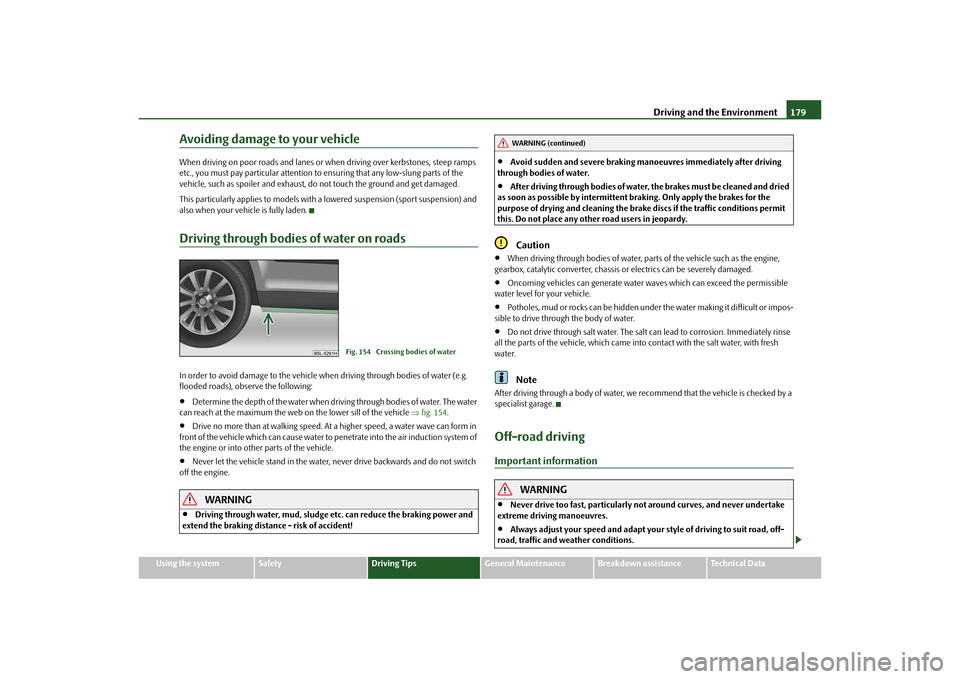
Driving and the Environment179
Using the system
Safety
Driving Tips
General Maintenance
Breakdown assistance
Technical Data
Avoiding damage to your vehicleWhen driving on poor roads and lanes or when driving over kerbstones, steep ramps
etc., you must pay particular attention to ensuring that any low-slung parts of the
vehicle, such as spoiler and exhaust, do not touch the ground and get damaged.
This particularly applies to models with a lowered suspen sion (sport suspension) and
also when your vehicle is fully laden.Driving through bodies of water on roadsIn order to avoid damage to the vehicle wh en driving through bodies of water (e.g.
flooded roads), observe the following:
Determine the depth of the water when driv ing through bodies of water. The water
can reach at the maximum the web on the lower sill of the vehicle fig. 154 .
Drive no more than at walking speed. At a higher speed, a water wave can form in
front of the vehicle which can cause water to penetrate into the air induction system of
the engine or into other parts of the vehicle.
Never let the vehicle stand in the water, never drive backwards and do not switch
off the engine.
WARNING
Driving through water, mud, sludge etc. can reduce the braking power and
extend the braking distance - risk of accident!
Avoid sudden and severe braking manoeuvres immediately after driving
through bodies of water.
After driving through bodies of water, the brakes must be cleaned and dried
as soon as possible by intermittent braking. Only apply the brakes for the
purpose of drying and cleaning the brake discs if the traffic conditions permit
this. Do not place any other road users in jeopardy.Caution
When driving through bodies of water, pa rts of the vehicle such as the engine,
gearbox, catalytic converter, chassis or electrics can be severely damaged.
Oncoming vehicles can generate water waves which ca n exceed the permissible
water level for your vehicle.
Potholes, mud or rocks can be hidden under the water making it difficult or impos-
sible to drive through the body of water.
Do not drive through salt water. The salt can lead to corrosion. Immediately rinse
all the parts of the vehicle, which came into contact with the salt water, with fresh
water.Note
After driving through a body of water, we recommend that the vehicle is checked by a
specialist garage.Off-road drivingImportant information
WARNING
Never drive too fast, particularly not around curves, and never undertake
extreme driving manoeuvres.
Always adjust your speed and adapt your style of driving to suit road, off-
road, traffic and weather conditions.
Fig. 154 Crossing bodies of water
WARNING (continued)
s2ug.6.book Page 179 Friday, April 9, 2010 2:24 PM
Page 184 of 271
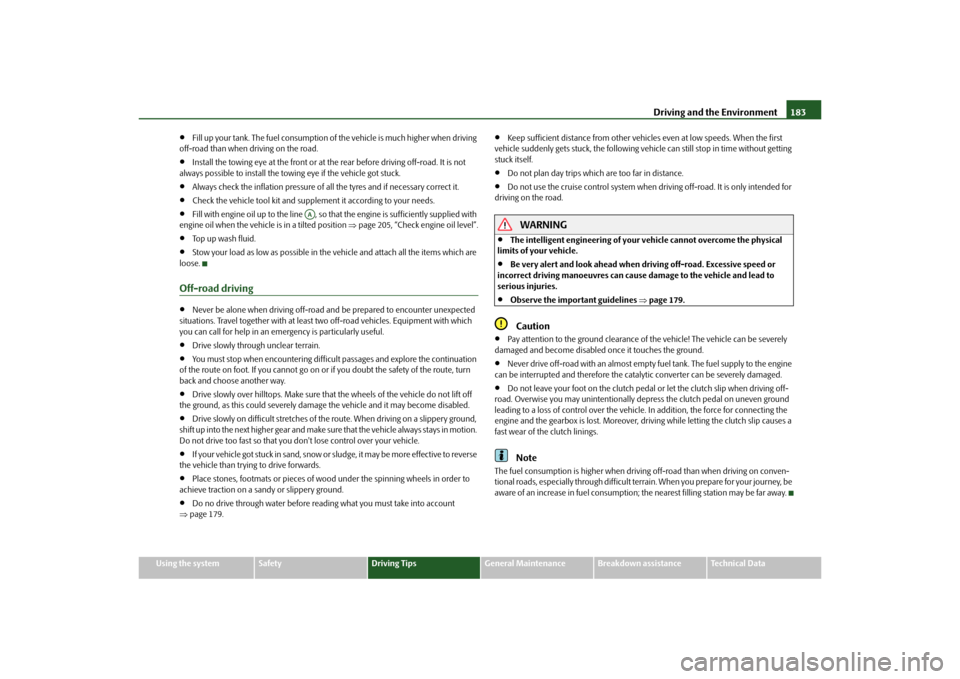
Driving and the Environment183
Using the system
Safety
Driving Tips
General Maintenance
Breakdown assistance
Technical Data
Fill up your tank. The fuel consumption of the vehicle is much higher when driving
off-road than when driving on the road.
Install the towing eye at the front or at the rear before driving off-road. It is not
always possible to install the towing eye if the vehicle got stuck.
Always check the inflation pressure of a ll the tyres and if necessary correct it.
Check the vehicle tool kit and supplement it according to your needs.
Fill with engine oil up to the line , so that the engine is sufficiently supplied with
engine oil when the vehicle is in a tilted position page 205, “Check engine oil level”.
Top up wash fluid.
Stow your load as low as possible in th e vehicle and attach all the items which are
loose.
Off-road driving
Never be alone when driving off-road and be prepared to encounter unexpected
situations. Travel together with at least two off-road vehicles. Equipment with which
you can call for help in an emer gency is particularly useful.
Drive slowly through unclear terrain.
You must stop when encountering difficul t passages and explore the continuation
of the route on foot. If you cannot go on or if you doubt the safety of the route, turn
back and choose another way.
Drive slowly over hilltops. Ma ke sure that the wheels of the vehicle do not lift off
the ground, as this could severely damage the vehicle and it may become disabled.
Drive slowly on difficult stretches of the route. When driving on a slippery ground,
s h i f t u p i n to t h e n e xt h i g h e r g e a r a n d m a ke s u re t h a t t he v e h i c l e a l w a y s s t a y s i n m o t i o n.
Do not drive too fast so that you do n't lose control over your vehicle.
If your vehicle got stuck in sand, snow or sludge, it may be more effective to reverse
the vehicle than trying to drive forwards.
Place stones, footmats or pieces of wood under the spinning wheels in order to
achieve traction on a sandy or slippery ground.
Do no drive throug h water before reading what you must take into account
page 179.
Keep sufficient distance from other vehicles even at low speeds. When the first
vehicle suddenly gets stuck, the following vehi cle can still stop in time without getting
stuck itself.
Do not plan day trips which are too far in distance.
Do not use the cruise control system when driving off-road. It is only intended for
driving on the road.
WARNING
The intelligent engineering of your ve hicle cannot overcome the physical
limits of your vehicle.
Be very alert and look ahead when driving off-road. Excessive speed or
incorrect driving manoeuvres can caus e damage to the vehicle and lead to
serious injuries.
Observe the important guidelines page 179.Caution
Pay attention to the ground clearance of the vehicle! The vehicle can be severely
damaged and become disabled once it touches the ground.
Never drive off-road with an almost empty fuel tank. The fuel supply to the engine
can be interrupted and therefore the cata lytic converter can be severely damaged.
Do not leave your foot on the clutch pedal or let the clutch slip when driving off-
road. Overwise you may unintentionally de press the clutch pedal on uneven ground
leading to a loss of control over the vehicle. In addition, the force for connecting the
engine and the gearbox is lost. Moreover, driving while letting the clutch slip causes a
fast wear of the clutch linings.Note
The fuel consumption is high er when driving off-road than when driving on conven-
tional roads, especially through difficult terr ain. When you prepare for your journey, be
aware of an increase in fuel consumption; the nearest filling station may be far away.
AA
s2ug.6.book Page 183 Friday, April 9, 2010 2:24 PM
Page 186 of 271
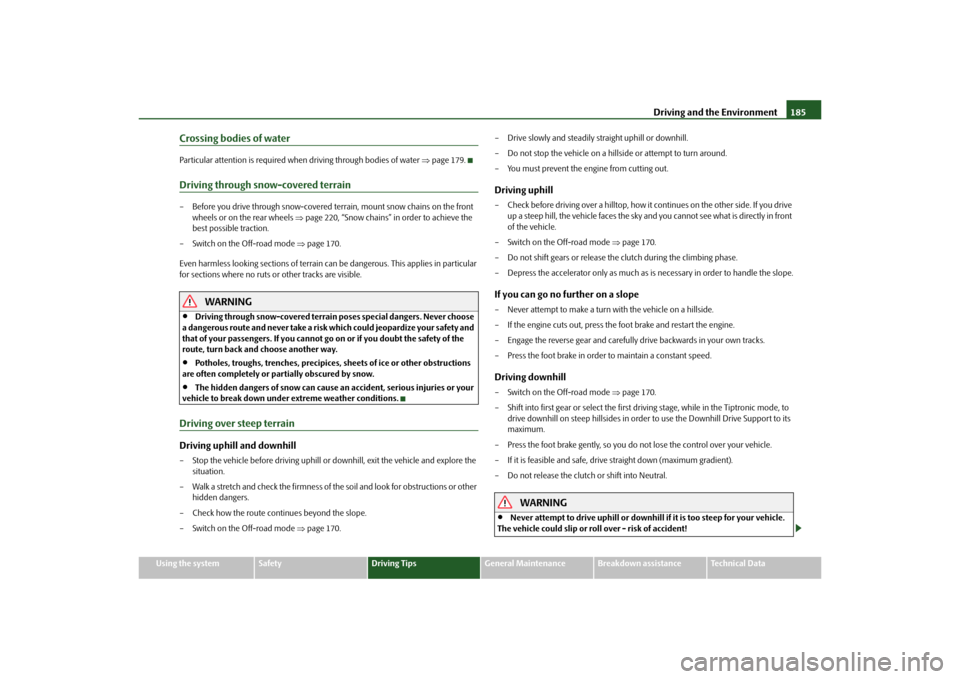
Driving and the Environment185
Using the system
Safety
Driving Tips
General Maintenance
Breakdown assistance
Technical Data
Crossing bodies of waterParticular attention is required when driving through bodies of water page 179.Driving through snow-covered terrain– Before you drive through snow-covered te rrain, mount snow chains on the front
wheels or on the rear wheels page 220, “Snow chains” in order to achieve the
best possible traction.
–Switch on the Off-road mode page 170.
Even harmless looking sections of terrain can be dangerous. This applies in particular
for sections where no ruts or other tracks are visible.
WARNING
Driving through snow-covered terrain poses special dangers. Never choose
a dangerous route and never take a risk which could jeopardize your safety and
that of your passengers. If you cannot go on or if you doubt the safety of the
route, turn back and choose another way.
Potholes, troughs, trenches, precipices , sheets of ice or other obstructions
are often completely or partially obscured by snow.
The hidden dangers of snow can cause an accident, serious injuries or your
vehicle to break down under extreme weather conditions.
Driving over steep terrainDriving uphill and downhill– Stop the vehicle before driv ing uphill or downhill, exit the vehicle and explore the
situation.
– Walk a stretch and check the firmness of the soil and look for obstructions or other hidden dangers.
– Check how the route continues beyond the slope.
–Switch on the Off-road mode page 170. – Drive slowly and steadily straight uphill or downhill.
– Do not stop the vehicle on a hillside or attempt to turn around.
– You must prevent the engine from cutting out.
Driving uphill– Check before driving over a hilltop, how it
continues on the other side. If you drive
up a steep hill, the vehicle faces the sky and you cannot see what is directly in front
of the vehicle.
– Switch on the Off-road mode page 170.
– Do not shift gears or release the clutch during the climbing phase.
– Depress the accelerator only as much as is necessary in order to handle the slope.If you can go no further on a slope– Never attempt to make a turn with the vehicle on a hillside.
– If the engine cuts out, press the foot brake and restart the engine.
– Engage the reverse gear and carefully drive backwards in your own tracks.
– Press the foot brake in order to maintain a constant speed.Driving downhill– Switch on the Off-road mode page 170.
– Shift into first gear or select the first driving stage, while in the Tiptronic mode, to drive downhill on steep hillsides in order to use the Downhill Drive Support to its
maximum.
– Press the foot brake gently, so you do not lose the control over your vehicle.
– If it is feasible and safe, drive straight down (maximum gradient).
– Do not release the clutch or shift into Neutral.
WARNING
Never attempt to drive uphill or downhill if it is too steep for your vehicle.
The vehicle could slip or roll over - risk of accident!
s2ug.6.book Page 185 Friday, April 9, 2010 2:24 PM
Page 187 of 271
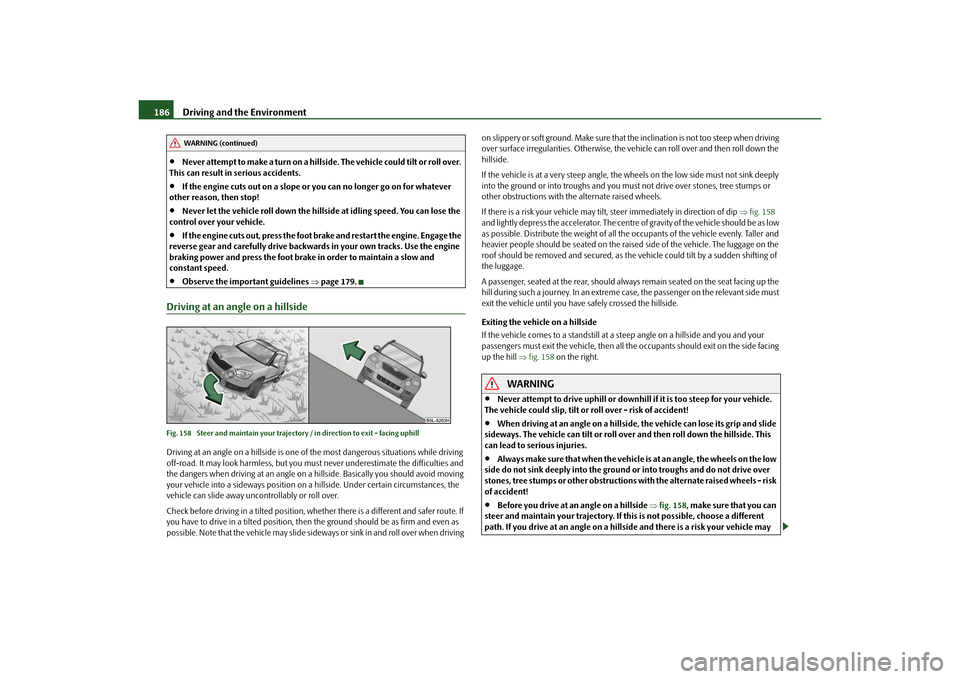
Driving and the Environment
186
Never attempt to make a turn on a hillside. The vehicle could tilt or roll over.
This can result in serious accidents.
If the engine cuts out on a slope or you can no longer go on for whatever
other reason, then stop!
Never let the vehicle roll down the hill side at idling speed. You can lose the
control over your vehicle.
If the engine cuts out, press the foot brake and restart the engine. Engage the
reverse gear and carefully drive backward s in your own tracks. Use the engine
braking power and press the foot brake in order to maintain a slow and
constant speed.
Observe the important guidelines page 179.
Driving at an angle on a hillsideFig. 158 Steer and maintain your trajectory / in direction to exit - facing uphillDriving at an angle on a hillside is one of the most dangerous situations while driving
off-road. It may look harmless, but you must never underestimate the difficulties and
the dangers when driving at an angle on a hillside. Basically you should avoid moving
your vehicle into a sideways position on a hillside. Under certain circumstances, the
vehicle can slide away uncon trollably or roll over.
Check before driving in a tilted position, whether there is a different and safer route. If
you have to drive in a tilted position, then the ground should be as firm and even as
possible. Note that the vehicle may slide sideways or sink in and roll over when driving on slippery or soft ground. Make sure that
the inclination is not too steep when driving
over surface irregularities. Otherwise, the vehicle can roll over and then roll down the
hillside.
If the vehicle is at a very steep angle, the wheels on the low side must not sink deeply
into the ground or into troughs and you mu st not drive over stones, tree stumps or
other obstructions with the alternate raised wheels.
If there is a risk your ve hicle may tilt, steer immedi ately in direction of dip fig. 158
and lightly depress the accelerator. The centre of gravity of the vehicle should be as low
as possible. Distribute the weight of all the occupants of the vehicle evenly. Taller and
heavier people should be seated on the rais ed side of the vehicle. The luggage on the
roof should be removed and secured, as the vehicle could tilt by a sudden shifting of
the luggage.
A passenger, seated at the rear, should always remain seated on the seat facing up the
hill during such a journey. In an extreme case , the passenger on the relevant side must
exit the vehicle until you have safely crossed the hillside.
Exiting the vehicle on a hillside
If the vehicle comes to a standstill at a st eep angle on a hillside and you and your
passengers must exit the vehicle, then all th e occupants should exit on the side facing
up the hill fig. 158 on the right.
WARNING
Never attempt to drive uphill or downhill if it is too steep for your vehicle.
The vehicle could slip, tilt or roll over - risk of accident!
When driving at an angle on a hillside, the vehicle can lose its grip and slide
sideways. The vehicle can tilt or roll over and then roll down the hillside. This
can lead to serious injuries.
Always make sure that when the vehicle is at an angle, the wheels on the low
side do not sink deeply into the ground or into troughs and do not drive over
stones, tree stumps or other obstructions with the alternate raised wheels - risk
of accident!
Before you drive at an angle on a hillside fig. 158 , make sure that you can
steer and maintain your trajectory. If this is not possible, choose a different
path. If you drive at an an gle on a hillside and there is a risk your vehicle may
WARNING (continued)
s2ug.6.book Page 186 Friday, April 9, 2010 2:24 PM